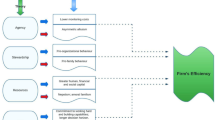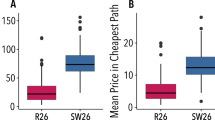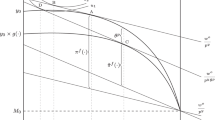Abstract
We argue that in the presence of transaction costs, observed productivity measures may in many cases understate the true productivity, as production data seldom distinguish between resources entering the production process and resources of a similar type that are sacrificed for transaction costs. Hence, both the absolute productivity measures and, more importantly, the productivity ranking will be distorted. A major driver of transaction costs is poor access to information and contract enforcement assistance. Social networks often catalyse information exchange as well as generate trust and support. Hence, we use measures of a firm’s access to social networks as a proxy for the transaction costs the firm faces. We develop a microeconomic production model that takes into account transaction costs and networks. Using a data set of 384 Polish farms, we empirically estimate this model and compare different parametric, semiparametric, and nonparametric model specifications. Our results generally support our hypothesis. Especially, large trading networks and dense household networks have a positive influence on a farm’s productivity. Furthermore, our results indicate that transaction costs have a measurable impact on the productivity ranking of the farms.


Similar content being viewed by others
Notes
A firm’s network position refers to the structural connectedness of the firm to other firms and other relevant actors.
Ego-centred networks are networks sampled with open boundaries which are structured around one actor, the ego. In our particular case, the ego is the farmer. In contrast, a full network is a network with closed boundaries where the ties between all actors in the closed set are mapped.
The following derivations can also be calculated for multiple outputs, but for simplicity, we only use a single output here.
Of course, some elements of \(\mathbf{x}^\mathrm{IN}\) might be zero (e.g. raw materials). If some inputs are only used for improving the productivity of the firm’s production activities, but not in the actual production (e.g. advisory services or consulting), we can add further elements to the vector \(\mathbf{x}^\mathrm{PD}\) and set these elements to zero.
Of course, some elements of \(\mathbf{x}^\mathrm{TD}\) might be zero (e.g. raw materials).
Name generators are a sampling technique to map ego-centred networks through a battery of questions, e.g. ‘Whom do you contact when looking for a job’ or ‘Name your most important trade partners’.
Strong ties are contacts that interact closely and frequently. An over-representation of strong ties in the sample can eventually lead to denser networks.
We also estimated other semiparametric models, but they were less suitable for our empirical application. For instance, we estimated smooth coefficient models, where the input quantities were modelled in parametric (Cobb–Douglas) form and the coefficients were allowed to vary based on location, education, experience, risk attitudes, and network parameters—and in some models also on the (logarithmic) input quantities in order to allow for the same flexibility in input quantities as a translog production function. Unfortunately, our data set does not have a sufficient number of observations to obtain reasonable estimation results from this specification. Even in a fully parametric specification with a Cobb–Douglas production function, where the five smooth coefficients (intercept and the slope coefficients of the four logarithmic input quantities) are linear functions of the three location dummies, three education dummies, experience, risk attitudes, and eight network parameters, the model has 85 coefficients. Allowing for the same flexibility in input quantities as a translog production function would require 16 additional coefficients. Modelling the smooth coefficients with a nonparametric approach further aggravates this problem. Therefore, a smooth coefficient model is unsuitable for our empirical application.
Furthermore, we estimated various partially linear models, where the (logarithmic) input quantities were modelled linearly (i.e. assuming a Cobb–Douglas functional form). These models had an extremely poor out-of-sample predictive performance (based on the procedure described in Sect. 5.2), which may not be surprising, as the results of most other models show that the effects of the (logarithmic) input quantities are nonlinear (see Sect. 5.1).
Finally, we estimated various partially linear models, where the network variables were modelled linearly, while the input quantities and the other explanatory variables were modelled nonparametrically. The results of these models were mostly similar to the results of the models that we present in Sect. 5. However, as these models are unable to detect nonlinearities in the effects of the network variables, we do not present the results of these models.
While the kernels for ordered categorical variables of Wang and van Ryzin (1981) and Racine and Li (2004) are clearly different, the kernels for unordered categorical variables of Aitchison and Aitken (1976) and Li and Racine (2004) have exactly the same shape, but a different specification of the bandwidth parameter, so that the choice between the kernels for unordered categorical variables does not make a difference if the bandwidth parameters are appropriately adjusted, e.g. by data-driven bandwidth selection (Czekaj and Henningsen 2013).
We were not able to test the statistical significance in the additive categorical regression spline models due to high multicollinearity.
The five individually insignificant network variables are also jointly insignificant in the OLS Cobb–Douglas model (\(P\) value 0.145), in the OLS translog model (\(P\) value 0.255), in the nonparametric model with bandwidths obtained by least-squares cross-validation (\(P\) value 0.189), and in the nonparametric model with bandwidths obtained according to the expected Kullback–Leibler criterion (\(P\) value 0.180). We have not tested the joint significance in the ACRS models, because this feature is not yet available in the “crs” package.
However, in contrast to a parametric linear regression (e.g. OLS), our nonparametric regression with large bandwidths still allows the marginal effects of the explanatory variables to differ between observations. In fact, each nonparametric estimation is similar to four linear (Cobb–Douglas) estimations for the four municipalities, where the estimation for each municipality also takes into account the observations of the three other municipalities using weights equal to the bandwidth of the location variable.
It would also be desirable to adjust the number of segments and the degrees of the spline functions, but to our knowledge, no procedure for this exists and the number of segments and the degrees of the spline functions must be integers, so that their adjustment by the same factors as the adjustments of the bandwidths of the kernel functions would probably in most cases not have been sufficient to adjust them (after rounding) to the previous or next integer value.
Please note that in the ACRS and NP models, the significance levels refer to the significance of the location variable, not to the significance of the effect of the individual municipalities. Thus, for these models, a significance symbol for Siemiątkowo does not mean that the productivity significantly differs between Siemiątkowo and Chotcza, but that there are significant productivity differences between at least two municipalities.
Please note that a gradient of \(\beta \) means that the effect of a change from zero to one is a change of \(100 \cdot (\exp (\beta ) - 1)\)%, while the effect of a change from one to zero is a change of \(100 \cdot (\exp (- \beta ) - 1)\)%, because the dependent variable (output) is logarithmised and most of our models are (virtually) linear in the (majority of) network parameters.
We did the same analysis based on the ACRS LS specification with all explanatory variables, but we only present the analysis based on the ACRS LS specification with fewer explanatory variables, because the resulting figures only slightly differ between the two ACRS LS specifications.
References
Aitchison J, Aitken CGG (1976) Multivariate binary discrimination by the kernel method. Biometrika 63(3):413–420
Bandiera O, Rasul I (2006) Social networks and technology adoption in northern mozambique. Econ J 116(514):869–902
Beckmann CM, Haunschild PR, Phillips DJ (2004) Friends or strangers? Firm-specific uncertainty, market uncertainty, and network partner selection. Organ Sci 15(3):259–275
Bradley SW, McMullen JS, Artz K, Simiyu EM (2012) Capital is not enough: innovation in developing economies. J Manag Stud 49(4):684–717
Burt RS (1984) Network items and the general social survey. Soc Netw 6:293–339
Buskens V (1999) Social networks and trust. Dissertation, Utrecht University.
Castilla EJ, Hwang H, Granovetter E, Granovetter M (2000) Social networks in Silicon Valley. In: Lee CM, Miller WF, Hancock MG, Rowen HS (eds) The Silicon Valley edge: a habitat for innovation and entrepreneurship. Stanford University Press, Stanford, pp 218–247
Czekaj T, Henningsen A (2013) Panel data specifications in nonparametric kernel regression: an application to production functions. IFRO Working Paper 2013/5, Department of Food and Resource Economics, University of Copenhagen
Dekker DJ (2001) Effects of positions in knowledge networks on trust. Tech. Rep. TI 2001–062/1, Tinbergen Institute
den Butter FAG, Mosch RHJ (2003) Trade, trust and transaction cost. Working Paper TI 2003–082/3, Tinbergen Institute, Amsterdam. http://dare.ubvu.vu.nl/bitstream/1871/9575/1/03082.pdf
Di Matteo T, Aste T, Gallegati M (2005) Innovation flow through social networks: productivity distribution in France and Italy. Eur Phys J B 47:459–466
Fafchamps M (2001) The role of business networks in market development in Sub-Saharan Africa. In: Hayami Y, Aoki M (eds) Community and market in economic development. Oxford University Press, Oxford, pp 186–214
Hayfield T, Racine JS (2008) Nonparametric econometrics: the np package. J Stat Softw 27(5):1–32
Henning CHCA, Zuckerman EW (2006) Boon and bane of social networking in markets with imperfect information: theory and evidence from Polish and Slovakian rural credit markets. Christian Albrechts University Kiel, Institute of Agricultural Economics
Henning CHCA, Henningsen G, Henningsen A (2012) Networks and transaction costs. Am J Agric Econ 94(2):377–385
Hsiao C, Li Q, Racine J (2007) A consistent model specification test with mixed discrete and continuous data. J Econ 140(2):802–826
Hurvich CM, Simonoff JS, Tsai CL (1998) Smoothing parameter selection in nonparametric regression using an improved Akaike information criterion. J R Stat Soc Ser B 60:271–293
Jenssen JI, Koenig HF (2002) The effect of social networks on resource access and business start-ups. Eur Plan Stud 10(8):1039–1046
Lau CM, Bruton GD (2011) Strategic orientations and strategies of high technology ventures in two transition economies. J World Bus 46:371–380
Levi M (2000) When good defenses make good neighbors: a transaction cost approach on trust, the absence of trust and distrust. In: Ménard C (ed) Institutions, contracts, and organizations: perspective from new institutional economics, chap 12. Edward Elgar, Chichester, pp 137–157
Li Q, Racine JS (2004) Cross-validated local linear nonparametric regression. Stat Sinica 14(2):485–512
Lin N (1999) Building a network theory of social capital. Connections 22(1):28–51
Luo Y (2003) Industrial dynamics and managerial networking in an emerging market: the case of China. Strateg Manag J 24:1315–1327
Ma S, Racine JS (2011) Inference for regression splines with categorical and continuous predictors, unpublished Working Paper, Department of Economics, McMaster University
Ma S, Racine JS (2012) Additive regression splines with irrelevant categorical and continuous regressors. Department of Economics Working Papers 2012–07, McMaster University. http://ideas.repec.org/p/mcm/deptwp/2012-07.html
Ma S, Racine JS, Yang L (2012) Spline regression in the presence of categorical predictors. Department of Economics Working Papers 2012–06, McMaster University. http://ideas.repec.org/p/mcm/deptwp/2012-06.html
Ménard C (2000) Enforcement procedures and governance structures: What relationship? In: Ménard C (ed) Institutions, contracts and organizations. Perspectives from new institutional economics, chap 17. Edward Elgar Pub., Cheltenham, pp 235–253
Nee V (1998) Norms and networks in economic and organizational performance. Am Econ Rev 88(2):85–89
Nie Z, Racine JS (2012) The crs package: nonparametric regression splines for continuous and categorical predictors. R J 4(2):48–56
Prajapati S, Biswas S (2011) Effect of entrepreneur network and entrepreneur self-efficacy on subject performance: a study of handicraft and handloom cluster. J Entrep 20(2):227–247
R Core Team (2014) R: a language and environment for statistical computing. R Foundation for Statistical Computing, Vienna, Austria. http://www.R-project.org/
Racine JS (1997) Consistent significance testing for nonparametric regression. J Bus Econ Stat 15:369–379
Racine JS, Li Q (2004) Nonparametric estimation of regression functions with both categorical and continuous data. J Econ 119(1):99–130
Racine JS, Parmeter CF (2014) Data-driven model evaluation: a test for revealed performance. In: Racine JS, Su L, Ullah A (eds) The Oxford handbook of applied nonparametric and semiparametric econometrics and statistics, Oxford handbooks in economics. Oxford University Press, Oxford, pp 308–345
Racine JS, Hart J, Li Q (2006) Testing the significance of categorical predictor variables in nonparametric regression models. Econom Rev 25:523–544
Ramsey JB (1969) Tests for specification errors in classical linear least-squares regression analysis. J R Stat Soc Ser B (Methodol) 31(2):350–371
Stam W, Arzlanian S, Elfring T (2014) Social capital of entrepreneurs and small firm performance: a meta-analysis of contextual and methodological moderators. J Bus Venture 29(1):152–173
Uzzi B (1996) The sources and consequences of embeddedness for the economic performance of organizations: the network effect. Am Sociol Rev 94(4):674–698
Wang MC, van Ryzin J (1981) A class of smooth estimators for discrete distributions. Biometrika 68:301–309
Williamson OE (2000) The new institutional economics: taking stock, looking ahead. J Econ Lit 38:595–613
Yu SH, Chiu WT (2013) Social networks and corporate performance: the moderating role of technical uncertainty. J Manag Issues 25(1):26–45
Acknowledgments
The authors are grateful to Jeff Racine, Martin Browning, Subal Kumbhakar, Chris Parmeter, and two anonymous referees for their valuable suggestions regarding the econometric analysis and for improving the paper. Funding was provided by the European Union’s sixth framework programme within the project Advanced-Eval. Arne Henningsen is grateful to the German Research Foundation (Deutsche Forschungsgemeinschaft, DFG) for financially supporting this research.
Author information
Authors and Affiliations
Corresponding author
Rights and permissions
About this article
Cite this article
Henningsen, G., Henningsen, A. & Henning, C.H.C.A. Transaction costs and social networks in productivity measurement. Empir Econ 48, 493–515 (2015). https://doi.org/10.1007/s00181-014-0882-y
Received:
Accepted:
Published:
Issue Date:
DOI: https://doi.org/10.1007/s00181-014-0882-y
Keywords
- Information networks
- Transaction costs
- Semiparametric estimation
- Nonparametric estimation
- Productivity analysis




